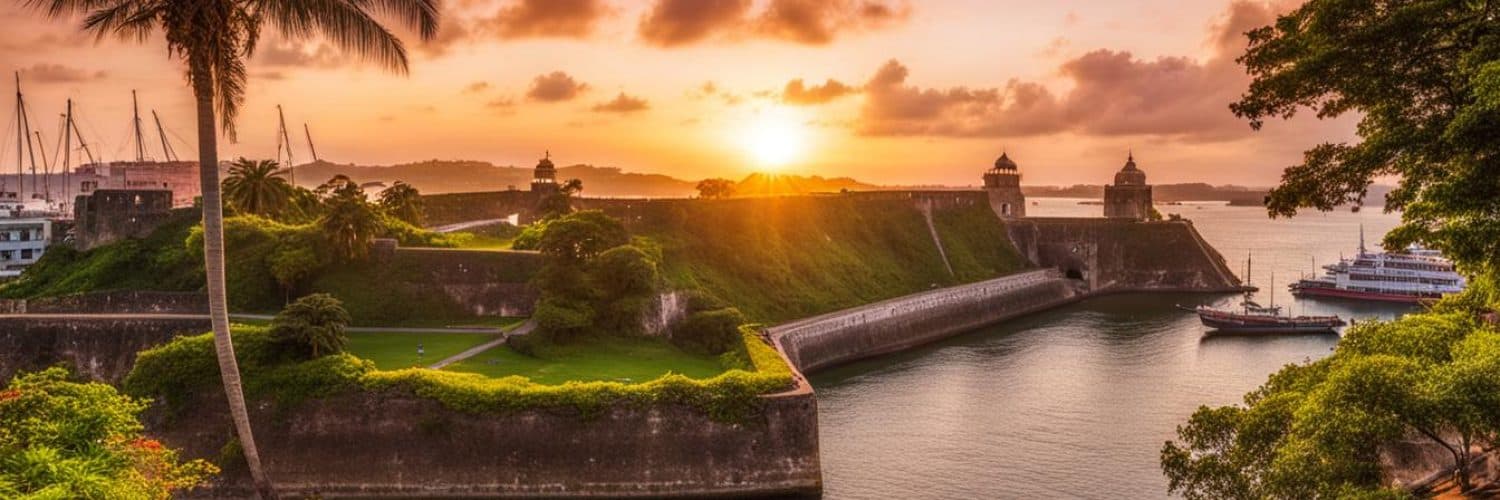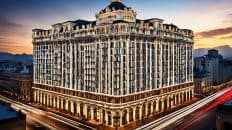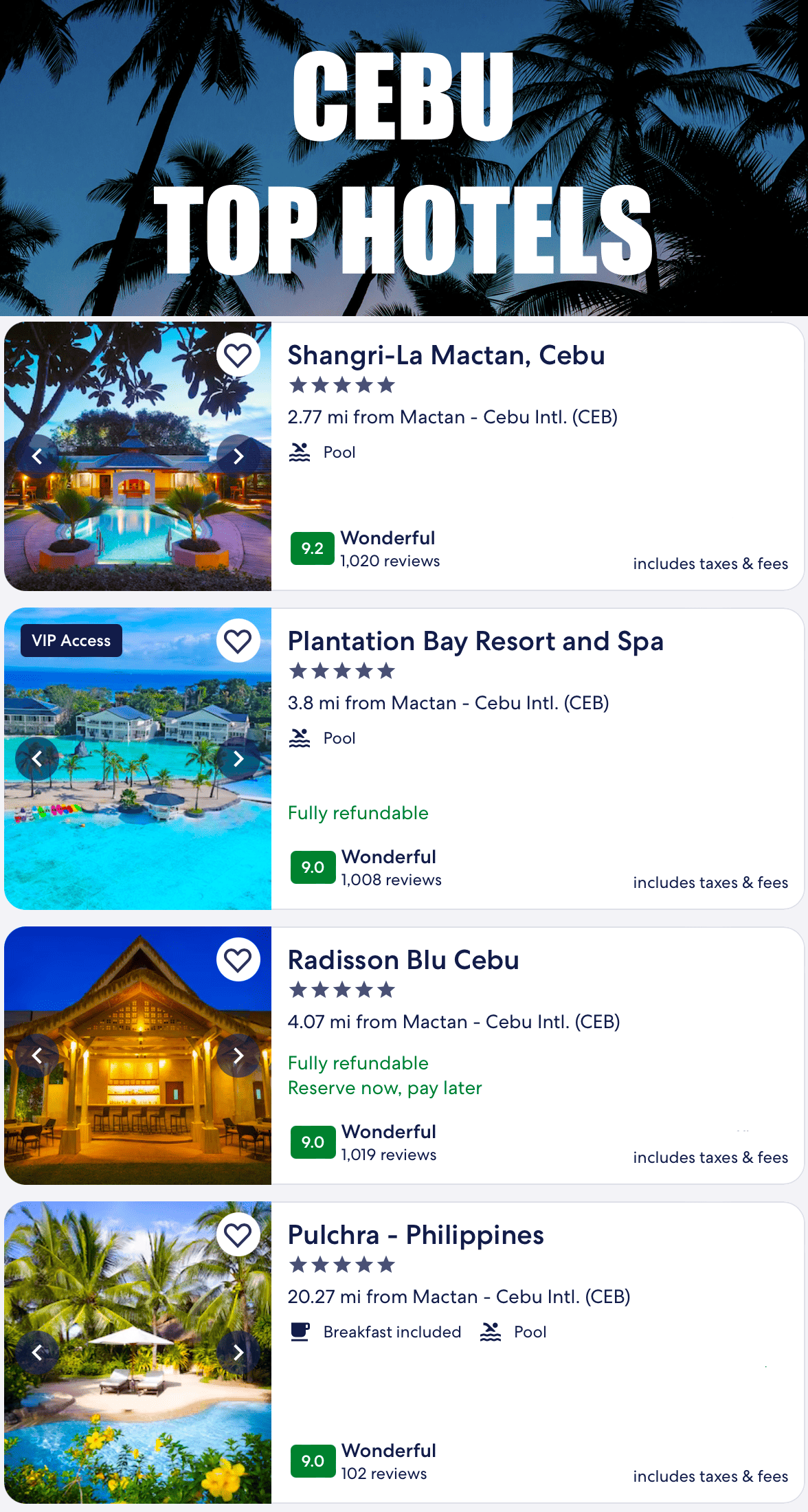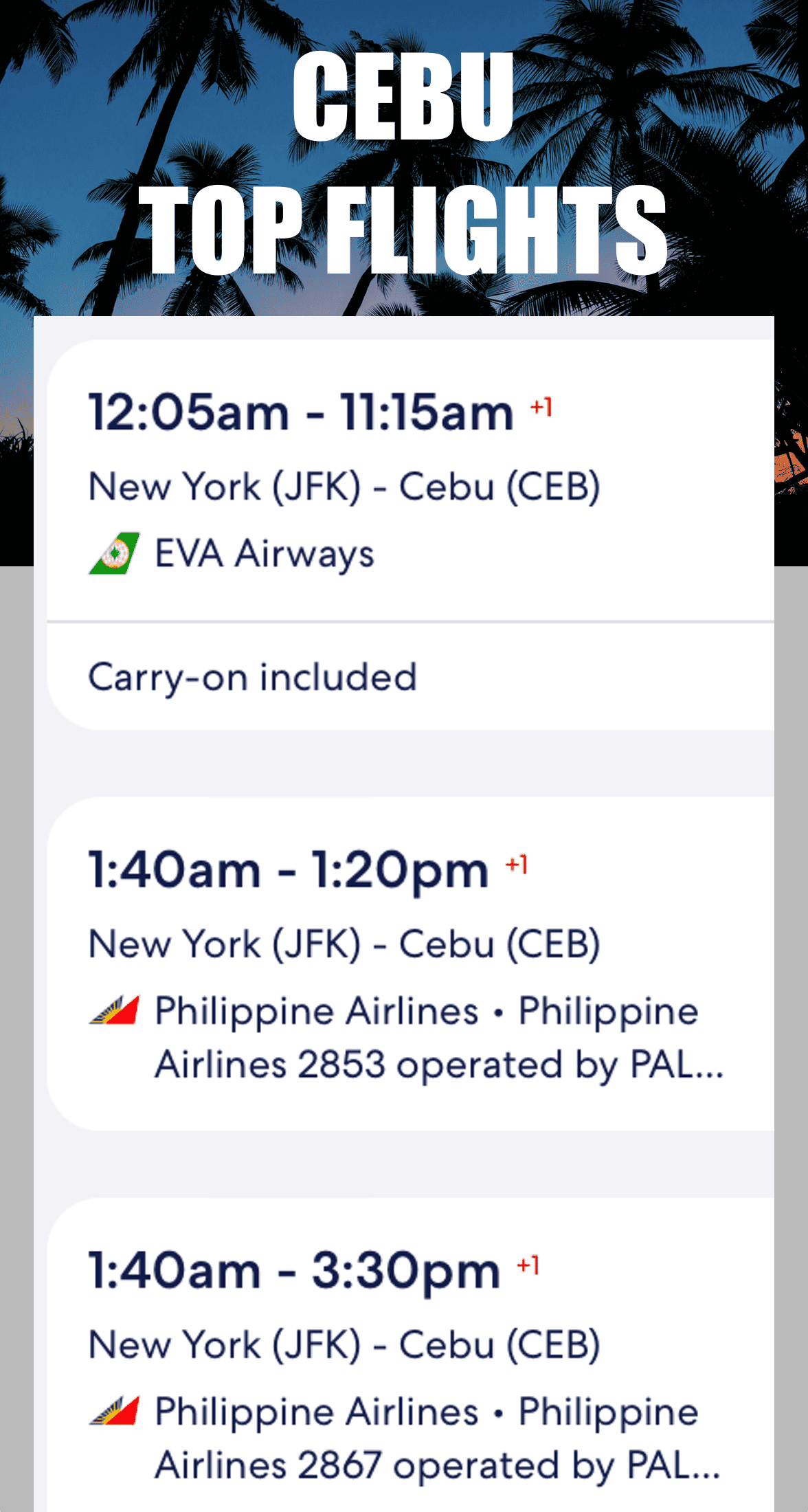Fort San Pedro, located in Cebu City, is a historical landmark and must-visit tourist attraction. As the oldest and smallest fort in the Philippines, it holds immense significance from the Spanish colonial period. Situated in Plaza Independencia, this fortress is a testament to the rich history of Cebu and its cultural heritage.
Built during the Spanish rule, Fort San Pedro is a triangular bastion fort with two sides facing the sea and one edge facing the land. Its cannons facing the sea and sturdy wooden fence reflect its historical presence. Today, the fort is a well-preserved historical park under the care of the Cebu City government.
Inside the fort, a museum houses a collection of preserved Spanish artifacts, including paintings, sculptures, old photographs, and documents. Visitors can delve into the island’s history and gain insights into its past.
Key Takeaways:
- Fort San Pedro is a historical landmark and top tourist attraction in Cebu City, Philippines.
- It is the oldest and smallest fort in the country, dating back to the Spanish colonial period.
- The fort’s unique triangular shape and well-preserved artifacts offer a glimpse into Cebu’s rich history.
- Located in Plaza Independencia, the fort is easily accessible and a must-visit for history enthusiasts.
- Exploring Fort San Pedro provides a remarkable experience and allows visitors to appreciate Cebu’s cultural heritage.
History of Fort San Pedro
When the Spanish landed in Cebu, the fort was initially built to provide security to the members of the Spanish expedition. Its construction commenced on the 5th of May 1565 after a man called Miguel Lopez de Legaspi arrived on the island. As I mentioned before, the fort was triangular and its wooden palisade enclosed a few fresh water wells. You can still find one operational well when you enter. It is speculated that the fort was named San Pedro after Legaspi’s flagship. The fort is the oldest triangular shaped fortification in the country. It served as the center of the first Spanish settlement in the Philippines. Later during the revolution (19th century), it was taken by the Filippinos. The fort served as a stronghold for their revolutionary activities.
If Legaspi hadn’t arrived in Cebu, the history of the Philippines may have been profoundly different. Known as the Captaincy General of the Philippines, the arrival of Miguel Lopez de Legazpi and his expedition marked the beginning of Spanish colonialism in the region. Legazpi established the first Spanish settlement in Cebu and utilized Fort San Pedro as a strategic outpost and defensive stronghold.
“Fort San Pedro, with walls of stone, stands at the landing place of the Spanish conquerors when they arrived in Cebu on that fateful day. The fort, built to resist invasions and repel attacks, was the bastion of the Spaniards during the heyday of the Spanish regime in the Far East.”
– Cebu City Government Website
Location of Fort San Pedro
Fort San Pedro, a historical monument and popular tourist attraction, is located in the heart of Cebu City, Philippines. Specifically situated at A. Pigafetta Street, Cebu City, the fort holds a prominent position in the bustling Plaza Independencia.
This strategic location makes Fort San Pedro easily accessible to both locals and tourists, offering a convenient opportunity to explore its rich history and cultural significance. The fort’s distinctive triangular shape makes it instantly recognizable and adds to its allure as a must-visit destination in Cebu City.
| Location | Coordinates | Address |
|---|---|---|
| Fort San Pedro | 10.294522°N, 123.854088°E | A. Pigafetta Street, Cebu City, Philippines |
| Plaza Independencia | 10.2939°N, 123.8827°E | Plaza Independencia, Cebu City, Philippines |
Why Visit Fort San Pedro?
Aside from its historical significance, Fort San Pedro offers a captivating experience with its well-preserved artifacts and picturesque surroundings. Visitors can immerse themselves in the rich heritage of Cebu while enjoying stunning views of the cityscape from the fort’s vantage point.
With its central location and historical importance, Fort San Pedro stands as a testament to the enduring legacy of the Spanish colonial period in the Philippines. It is a destination that should not be missed by anyone seeking to discover the cultural treasures of Cebu City.
How to Get to Fort San Pedro
Getting to Fort San Pedro in Cebu City is easy with multiple transportation options available. Whether you prefer the local charm of a jeepney ride or the convenience of a MyBus, there are ways to reach this historical landmark. Follow the directions below to ensure a hassle-free journey:
By Jeepney:
If you’re looking for an authentic Cebu City experience, hop on a jeepney and head to Plaza Independencia. Look for jeepneys that pass by Plaza Independencia or ask locals for assistance. Upon arrival at Plaza Independencia, you can easily walk to Fort San Pedro.
By MyBus:
If you prefer a more comfortable and convenient option, take a MyBus from SM City Cebu to Plaza Independencia (Talisay route). Enjoy a relaxing ride and soak in the city views as you approach your destination. Alight at the stop nearest to SRP’s entrance road and proceed to Plaza Independencia, which is just across from Malacanang sa Sugbo.
| Transportation Option | Route | Description |
|---|---|---|
| Jeepney | Plaza Independencia | Look for jeepneys passing by Plaza Independencia. |
| MyBus | SM City Cebu to Plaza Independencia (Talisay route) | Take the MyBus route from SM City Cebu to Plaza Independencia, alight at the stop nearest to SRP’s entrance road. |
Whichever transportation option you choose, make sure to enjoy the journey and immerse yourself in the charm of Cebu City. Before you know it, you’ll be exploring the fascinating history of Fort San Pedro.
Opening Hours and Entrance Fee
When planning your visit to Fort San Pedro in Cebu City, it’s essential to familiarize yourself with the opening hours and entrance fees for this historical landmark. Knowing these details in advance will help you make the most of your visit and ensure a smooth experience.
Opening Hours:
Fort San Pedro is open to visitors from 8 AM to 7 PM. These operating hours provide ample time for exploration and learning about the rich history and cultural heritage of Cebu City.
Entrance Fee:
There is a small entrance fee to enter Fort San Pedro, which allows you access to the fort and its museum. It’s important to note that the entrance fee applies to both locals and foreigners and may vary depending on age and residency status.
Visiting Hours:
| Visitor Category | Rate |
|---|---|
| Adults | $2 |
| Children (6-12 years old) | $1 |
| Senior Citizens (60 years old and above) | $1 |
With its affordable entrance fee, Fort San Pedro offers an exceptional value for those interested in delving into the history of Cebu City and experiencing its cultural significance. The fee grants you access to explore the well-preserved fort and its museum, where you can immerse yourself in the Spanish colonial period and discover fascinating artifacts and historical exhibits.
Whether you’re a history enthusiast, a curious traveler, or simply looking for an educational and enriching experience in Cebu City, a visit to Fort San Pedro is a must. Don’t miss the opportunity to explore this iconic landmark and learn about its significant role in shaping the history of the Philippines.
Attractions at Fort San Pedro
Fort San Pedro offers a range of attractions that showcase the rich history and cultural heritage of Cebu City. Visitors can explore the museum inside the fort, which houses a collection of historical artifacts, including Spanish paintings, sculptures, old photographs, preserved items, and documents. These artifacts provide fascinating insights into the city’s past and the influence of Spanish colonialism.
One of the notable attractions within the museum is Our Lady of the Fort, a replica of the second oldest image of the Virgin Mary in the Philippines. This religious artifact holds great significance and offers visitors a chance to appreciate the religious traditions that have shaped the region.
The fort also features the Pistaym, a captivating collection of vintage city photographs. These photographs provide a glimpse into the transformation of Cebu City over the years, allowing visitors to witness the changes and development that the city has undergone.
For a breathtaking view, visitors can head to the upper level of the fort. From here, you can enjoy panoramic views of the surrounding area, including the picturesque Plaza Independencia and the scenic coastline. As you explore the upper level, you’ll also come across three Bastions, each dedicated to different individuals who played significant roles in the fort’s history.
| Attraction | Description |
|---|---|
| Fort San Pedro Museum | A collection of Spanish artifacts, including paintings, sculptures, photographs, and documents. |
| Our Lady of the Fort | A replica of the second oldest image of the Virgin Mary in the Philippines. |
| Pistaym | A collection of vintage city photographs showcasing the transformation of Cebu City over the years. |
| Upper Level | Offers stunning views of Plaza Independencia and the coastline, with three Bastions dedicated to historical figures. |
These attractions at Fort San Pedro provide visitors with a unique and immersive experience, allowing them to delve into the history and heritage of Cebu City. Whether you’re a history enthusiast or simply curious about the past, a visit to Fort San Pedro is a must when exploring the vibrant city of Cebu.
Best Time to Visit Fort San Pedro
Fort San Pedro in Cebu City is a captivating historical landmark that attracts visitors from near and far. To make the most of your visit, it’s essential to consider the best time to experience this remarkable site.
Visiting Hours
The fort welcomes visitors daily during its operating hours, from 8 AM to 7 PM. This gives you ample time to explore its fascinating history, admire the architecture, and immerse yourself in the cultural heritage of Cebu.
Peak Season vs. Off-Peak Season
Like any popular tourist attraction, Fort San Pedro experiences peak and off-peak seasons. During the peak season, which typically falls during holidays and school vacations, the fort can get crowded with both locals and tourists. If you prefer a more serene experience with fewer crowds, it’s recommended to visit during the off-peak season. However, even during quieter periods, it’s important to note that the fort remains a popular destination, so there may still be some visitors.
Weather Conditions
Cebu City enjoys a tropical climate throughout the year, characterized by warm temperatures and occasional rain showers. It’s important to consider the weather conditions when planning your visit to Fort San Pedro. Generally, the months of January to May are considered the driest period, making them ideal for exploring outdoor attractions. However, it’s always a good idea to check the weather forecast before your visit for the most accurate information.
Whether you choose to explore Fort San Pedro during the peak or off-peak season, or visit during the drier months, one thing is for certain – this historical gem in Cebu City will leave you in awe of its rich heritage and architectural beauty.
| Visiting Hours | Peak Season | Off-Peak Season | Weather Conditions |
|---|---|---|---|
| 8 AM to 7 PM | Crowded with both locals and tourists | Fewer crowds | Tropical climate throughout the year |
| Higher chance of rain | Serene experience | Driest period: January to May |
Nearby Attractions
When visiting Fort San Pedro in Cebu City, you’ll find yourself surrounded by a range of exciting attractions waiting to be explored. Here are some nearby places of interest that you won’t want to miss during your visit:
Plaza Independencia
Located just a stone’s throw away from Fort San Pedro, Plaza Independencia is a historic park that offers a peaceful and relaxing environment. Take a leisurely stroll through the park, admire the beautifully manicured gardens, and learn more about Cebu’s rich history.
Basilica del Santo Niño
A short distance from Fort San Pedro is the iconic Basilica del Santo Niño, one of the oldest Roman Catholic churches in the Philippines. This centuries-old religious site is home to the renowned Santo Niño de Cebu, a religious relic that holds deep cultural and religious significance.
Carbon Market
Experience the vibrant atmosphere of Carbon Market, Cebu’s oldest and largest public market. Here, you can immerse yourself in the local culture, browse through a wide variety of fresh produce, handicrafts, and clothing, and get a taste of authentic Cebuano flavors.
Cebu Metropolitan Cathedral
Situated nearby, the Cebu Metropolitan Cathedral is a majestic structure that showcases impressive architectural design. Step inside to admire its stunning interiors, adorned with intricate stained glass windows, and soak in the serene atmosphere of this significant religious landmark.
Fort San Pedro’s ideal location allows visitors to conveniently explore these nearby attractions, providing a comprehensive and enriching experience of Cebu City’s cultural and historical heritage.
| Attraction | Description |
|---|---|
| Plaza Independencia | A historic park offering a peaceful environment |
| Basilica del Santo Niño | One of the oldest Roman Catholic churches in the Philippines |
| Carbon Market | Cebu’s oldest and largest public market |
| Cebu Metropolitan Cathedral | A majestic cathedral with stunning architectural design |
Fort San Pedro Today
Fort San Pedro, located in Cebu City, has transformed into a thriving historical park under the care and administration of the Cebu City government. This iconic fort stands as a testament to the preservation of Cebu’s rich cultural heritage and plays a significant role in showcasing its historical significance.
With its well-maintained grounds and fascinating exhibits, Fort San Pedro offers visitors a unique glimpse into the past. The spacious lawn surrounding the fort provides an ideal venue for hosting a variety of special occasions, including weddings, birthdays, and other memorable events. The fort’s picturesque setting and historical charm make it a popular choice for those seeking to create unforgettable memories.
However, please note that permits from the designated personnel are required to host events within the fort’s premises. This ensures the preservation and respect for this historical landmark, allowing it to be enjoyed by generations to come.
Fort San Pedro, Cebu City
| Event | Permit Required |
|---|---|
| Weddings | Yes |
| Birthdays | Yes |
| Special Occasions | Yes |
Conclusion
Fort San Pedro is truly a historical gem in Cebu City, offering visitors a captivating journey into the Spanish colonial legacy and the island’s rich history. As one of the top attractions in Cebu City, this well-preserved fort stands as a testament to the cultural heritage of the region.
Visiting Fort San Pedro is a must for both locals and tourists, as it provides a unique opportunity to explore Cebu’s fascinating past. Inside the fort, visitors can marvel at the array of Spanish artifacts, including paintings, sculptures, and old photographs, which offer a glimpse into the lives of the early settlers.
Aside from its historical significance, Fort San Pedro also boasts stunning views and a serene atmosphere, making it a perfect place for reflection and appreciation. Whether you’re exploring the bastions or strolling through the spacious lawn, the fort’s charm is truly captivating.
For those seeking an immersion into Cebu’s cultural heritage and a chance to uncover the Spanish colonial legacy, Fort San Pedro is a must-visit destination. Prepare to be captivated by the rich historical tapestry that unfolds within the walls of this iconic fort, and let yourself be transported back in time.
FAQ
What is the history of Fort San Pedro?
Fort San Pedro was initially built in 1565 by Miguel Lopez de Legazpi to provide security for the Spanish expedition. It served as the center of the first Spanish settlement in the Philippines and later became a stronghold for Filipino revolutionaries during the 19th century.
Where is Fort San Pedro located?
Fort San Pedro is located at A. Pigafetta Street, Cebu City, Philippines, specifically in Plaza Independencia. It is a popular historical monument and tourist attraction in Cebu City.
How can I get to Fort San Pedro?
To reach Fort San Pedro, you can take a jeepney or a MyBus to Plaza Independencia or the SRP’s entrance road. There are multiple transportation options available, making it easily accessible for visitors.
What are the opening hours and entrance fee for Fort San Pedro?
Fort San Pedro is open to visitors from 8 AM to 7 PM. There is a small entrance fee applicable to both locals and foreigners, with different rates for adults, children, and senior citizens.
What attractions can I find at Fort San Pedro?
Inside Fort San Pedro, there is a museum that houses numerous historical artifacts, including Spanish paintings, sculptures, photographs, preserved items, and documents. Visitors can also see Our Lady of the Fort, a replica of the second oldest image of the Virgin Mary in the Philippines, and explore the Pistaym, a collection of vintage city photographs.
When is the best time to visit Fort San Pedro?
The best time to visit Fort San Pedro is during its operating hours, from 8 AM to 7 PM. It is recommended to visit during the off-peak season to avoid large crowds. However, the fort is a popular tourist attraction, so there may still be some visitors even during quieter periods. It’s also important to consider weather conditions, as Cebu can experience tropical weather throughout the year.
What are some nearby attractions to Fort San Pedro?
Fort San Pedro is surrounded by various attractions in Cebu City. Within close proximity, visitors can explore Plaza Independencia, Basilica del Santo Niño, Carbon Market, and Cebu Metropolitan Cathedral, which are all must-visit sites for those interested in Cebu’s cultural and historical heritage.
What is the significance of Fort San Pedro today?
Today, Fort San Pedro is a historical park under the care and administration of the Cebu City government. It serves as a testament to Cebu’s cultural heritage and plays a significant role in preserving its historical significance. The fort is also used as a venue for special occasions such as weddings, birthdays, and other events.
Is Fort San Pedro a must-visit attraction in Cebu City?
Absolutely! Fort San Pedro is a historical gem that offers visitors a glimpse into the Spanish colonial legacy and the island’s rich history. It is a must-visit attraction that showcases Cebu’s cultural heritage and provides a unique experience for both locals and tourists.











Add comment